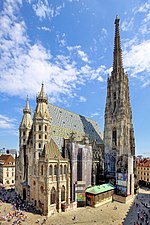Trams in Vienna

Trams in Vienna (German: Wiener Straßenbahn, in everyday speech also Bim or Tramway) are a vital part of the public transport system in Vienna, capital city of Austria. In operation since 1865, with the completion of a 2 km route to industrial estates near Simmering, it reached its maximum extent of 292 km in 1942. In February 2015, it was the fifth largest tram network in the world, at about 176.9 kilometres (109.9 mi) in total length and 1,071 stations.The trams on the network run on standard gauge track. Since 1897, they have been powered by electricity, at 600 V DC. The current operator of the network is Wiener Linien. In 2013, a total of 293.6 million passengers travelled on the network's trams. As of 2013, there were 525 tramcars in Vienna's tram fleet, including 404 trams or tramsets scheduled for service during peak periods, comprising 215 single cars and 189 motor and trailer sets.
Excerpt from the Wikipedia article Trams in Vienna (License: CC BY-SA 3.0, Authors, Images).Trams in Vienna
Stephansplatz, Vienna Innere Stadt
Geographical coordinates (GPS) Address Nearby Places Show on map
Geographical coordinates (GPS)
| Latitude | Longitude |
|---|---|
| N 48.208166666667 ° | E 16.372536111111 ° |
Address
Stephansplatz
Stephansplatz
1010 Vienna, Innere Stadt
Austria
Open on Google Maps








